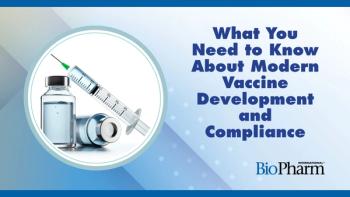
- BioPharm International-03-01-2013
- Volume 26
- Issue 3
The Lifecycle Change of Process Validation and Analytical Testing
BioPharm International spoke with industry experts about the effect FDA's 2011 process validation guidance has had on industry.
In the two years since the publication of FDA's final process validation guidance (1), how has this new lifecycle approach affected the way the industry performs validation? BioPharm International spoke with Hal Baseman, COO and principal at ValSource LLC and co-leader of the Parenteral Drug Association Process Validation Interest Group; Paul Smith, EMEAI laboratory compliance product specialist at Agilent; and Ian Jones, CEO, and Luke Kiernan, technical services director, of Innopharma Labs in Dublin, about the impact FDA's process validation guidance has had on analytical testing and validation.
CONTINUOUS PROCESS VERIFICATION
BioPharm:
What are the key elements of continuous process verification?
Jones (Innopharma Labs): A manufacturer can only truly understand their process and successfully demonstrate continued process verification through the implementation of process analytical testing (PAT) technologies to support the monitoring and control of product critical to quality attributes. I think material understanding throughout the manufacturing process from the product development phase onwards will not only support a robust commercial manufacturing process but can also reduce the burden of scale-up and technology transfer, thereby supporting product-divestment initiatives. The implementation of the new FDA guidelines on process validation will not only meet the expectations of the regulator but can also ensure the success of business demands such as lean scale-up, commercial manufacture, and technology transfer.
Smith (Agilent): Continued process verification requires an ongoing collection of data and evaluation of the performance of the process using the data collected. Historically, organizations tended to limit the "dimensionality" of the process data they gathered and monitored. Typically, this included a smaller number of discrete pieces of data, significantly less than that generated by continuous process monitoring as part of the lifecycle approach.
The identification, training, and use of appropriate statistical tools in the lifecycle approach are essential to the success. To detect a small change in a process or a process drift, the underlying variability of the process when operating 'normally' must be understood. Automated algorithms can fail. Typically, this can occur when there is some new source of variation/change in the relationship between the data that are being monitored that impact the underlying assumptions in the automated algorithms. Reliance on complex and sophisticated sales algorithms in the stock market is an example of this type of error. On the other hand, humans can make simple errors. Therefore, finding a balance between relying on semi-automated statistical tools and human monitoring is potentially one of the key elements to success.
APPLYING PAT
BioPharm: How may a given manufacturing process (including equipment design and operation) and analytical testing need to be modified to accommodate this lifecycle approach?
Baseman (ValSource): PAT can be a key element of continuous process verification. In-line, continuous monitoring, and control systems, such as those associated with PAT, are helpful in maintaining and assuring process control. Assurance of process control can be obtained by observation, inspection, or evaluation of process parameters and product attributes. Where complete observation is not possible, companies need to predict process outcome. Validation is the prediction of outcomes that cannot be fully observed, based on information we can observe. The more that [we] can observe, the more accurate the prediction.
In-line monitoring and control systems allow for more process observation, as well as better control of the process, further assuring process performance. In addition, they provide effective knowledge-management tools, providing information that can be utilized for future validation activities.
Jones (Innopharma Labs): I think PAT technologies can support all aspects of the product lifecycle—process development, scale-up, commercial manufacture, and technology transfer. You can't successfully conduct these lifecycle activities without intimate process understanding. This is only achieved on a batch-to-batch basis through real-time in-line PAT. Where this is not possible, on-line or at-line are also a necessary compromise.
Smith (Agilent): The lifecycle approach represents a different way of designing, building, and monitoring manufacturing processes. Within those processes, many of the key process stages associated with manufacturing have not changed significantly: blending, distillation, drying, and crystallization, for example. Many early PAT applications have been an adoption of laboratory instrumentation to process operation. A key challenge of this early PAT adoption, such as near infrared has been the limitations of access points in the manufacturing equipment, where a probe, signal, or at-line sampling point can be implemented. Cutting a hole in a glass-lined vessel is simply not an option. Therefore, the use of PAT must be considered at the process-design stage.
Generally, the simpler the technology and an understanding of the underlying relationship between what the PAT device is actually measuring and how the results will be used to monitor/adjust the process, potentially, the more robust the process should be. Therefore, simple PAT applications designed to support these discrete process stages are required. All PAT applications need to have some assessment of 'is it working correctly' built in, as well as appropriate means of efficiently performing 'instrumental activity' such as maintenance and/or calibration.
LIFECYCLE VERSUS TRADITIONAL VALIDATION
BioPharm: How does a lifecycle approach to process validation that employs risk-based decision-making throughout that lifecycle differ from traditional validation protocol and practice?
Baseman (ValSource): The principles of any effective process validation approach should consider risk to product quality and quality risk management tools in validation-related decisions; glean information from process design studies to identify process variables; develop control strategies and use sound scientific rational to test the effectiveness of those strategies during the qualification of the process; and monitor variability of commercial manufacturing batches to support maintenance of the validated state and look for ways to improve and optimize the process.
Jones (Innopharma Labs): There is a significant difference. With additional material understanding and a greater development focus, there is tremendous potential to reduce the process qualification burden and enhance process robustness throughout the lifecycle of the commercial product. Through the adoption of a lifecycle approach, there is the opportunity to not only continuously verify your process but also to continuously improve your process through greater automation, operator understanding, and PAT-instrument implementation. If adopted correctly, this guideline is good news for the regulator, the pharmaceutical manufacturer, and the patient because we will see more robust, reliable, and better value products brought to market.
Smith (Agilent): The original 1987 FDA process validation document was implemented at a time where compliance thinking was quite different to what it is today. At the time, the emphasis was more on 'Locking down the process' and generating documented evidence. In other words, the process was fixed and the emphasis was on the qualification documentation.
A key industry interpretation of the 1987 guidelines was the implementation of three validation batches during the process validation. This 'requirement' was not expressly stated in the 1987 guide, but rapidly became the 'industry norm.' A process could be considered validated if the results of the three validation batches passed specification, and the suite of qualification documents produced were well written. Ultimately, this potentially contributed towards a mind-set that validation could be bolted on to a process while the underling science and variability of the process might not have been well understood and problems were often encountered when processes were transferred between organizations. The 2011 guidance aligns process validation with product lifecycle principles that are now part of current regulatory thinking and principles.
CHALLENGES
BioPharm: What are the key challenges in implementing a lifecycle approach to process validation compared to the traditional process validation?
Baseman (ValSource): Companies used to running 'three batches' to qualify processes will need qualified resources to develop scientifically sound process validation plans, collect and analyze process performance metrics, and answer the question: how does what you do to validate the process, and provide assurance that the process is adequately controlled?
Companies may not yet have the systems in place to identify and transfer information from process design related groups to the people responsible for planning and conducting the process qualification studies. Also, companies may be concerned that using prior knowledge from previously validated processes to support the validation of new processes will expose those older processes to regulatory scrutiny.
Additionally, companies, which use CMOs and other outsourcing organizations, may not yet have the systems in place to adequately capture and transfer information needed to support the lifecycle approach to and from those organizations. And lastly, companies uncovering opportunities for process improvement during Stage 3, Continued Process Verification may be concerned that submitting changes to those processes will risk further regulatory scrutiny to already 'validated' processes.
Kiernan (Innopharma Labs): The guideline requirements are that the manufacturer must judge whether it has gained sufficient process understanding to justify commercial distribution of the product. The initial challenge for the manufacturer is to understand what sufficient process understanding 'looks like'. In Stage I, what level of design-of-experiment work is required? In Stage II, How many validation batches are sufficient (is three still the magic number)? And in Stage III, how much additional testing/monitoring is required? A greater knowledge of statistics and statistical control is now required by the manufacturer compared to when the traditional approach to process validation was in place.
Other challenges relate to legacy products that now fall into Stage III of the lifecycle. The same level of data-driven process understanding may not be available for these products as for new products. The challenge for manufacturers is to meet the requirements of the guidelines in a cost effective manner, for legacy products.
BioPharm: Overall, how has the FDA process validation guidance changed validation in pharmaceutical manufacturing?
Jones (Innopharma Labs): I think better material and process understanding are essential to the lean development and manufacture of robust and cheaper products. As the pharmaceutical industry transitions to the emerging markets, where reduced pricing structures and localized manufacture are expected, the implementation of these guidelines, in parallel with greater PAT technology implementation, and even the transition toward continuous manufacturing platforms, will become essential to sustain a successful business model.
Smith (Agilent): Validation is no longer considered as an activity that can be 'bolted on' to a process; it has to be designed in. This is resulting in a change of mindset towards a realization that validation is a value-added activity and not simply a cost.
Baseman (ValSource): The 2011 FDA guidance tracks well with the principles for lifecycle activities presented in ICH Q8, Q9, and Q10. And other regulatory agencies, including the European Medicines Agency, appear to recommending similar approaches. The new FDA guidance brings a science focus back to process validation. It may take time for companies and regulators to fully embrace it, but I am certain its use will result in more effective process control and improved processes.
REFERENCE
1. FDA, Guidance for Industry, Process Validation: General Principles and Practices, CDER (January 2011).
Articles in this issue
over 12 years ago
Lyophilization: A Primerover 12 years ago
Vaccine Innovation Yields New Products and Processesover 12 years ago
Aggregation of Monoclonal Antibody Products: Formation and Removalover 12 years ago
Outsourcing Nontraditional Protein Expression Systemsover 12 years ago
Standards-Setting Activities on Impuritiesover 12 years ago
Report from Brazilover 12 years ago
Catching Upover 12 years ago
Advances in PAT for Parenteral Drug ManufacturingNewsletter
Stay at the forefront of biopharmaceutical innovation—subscribe to BioPharm International for expert insights on drug development, manufacturing, compliance, and more.





